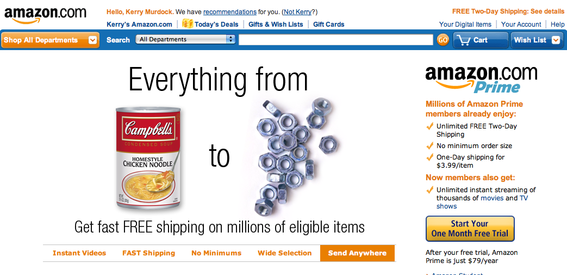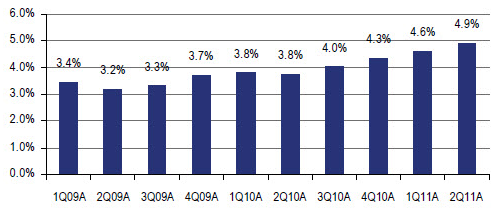For $79 a year, Amazon customers who join the Prime membership program get unlimited free two-day shipping on eligible items with no minimum order size. For $3.99 an item, a Prime customer can get one-day shipping. The program, established in 2005, is available in France, Germany, Great Britain, and Japan as well as the United States.
While this program may seem to be simply about shipping, it is really about bolstering customer loyalty and encouraging consumers to buy more products than they might otherwise purchase.
Amazon is very tight-lipped about any quantitative data involving the Prime program. However, Robbie Schwietzer, vice president of Amazon Prime told Bloomberg Businessweek magazine, “In all my years here, I don’t remember anything that has been as successful at getting customers to shop in new product lines.”

Amazon’s Prime program has been hugely successful.
Prime Membership Facts
Eugene Munster, a senior research analyst at investment bank Piper Jaffray who covers Amazon, performed a study of the Prime program last year. His findings are insightful about the success of Prime. He updated some of the figures for 2011. Among them:
- In 2009, Amazon had 2 million Prime members. In 2011, Prime has 5 million members out of a total 121 million Amazon customers. Although that represents only four percent of all customers, Prime is growing at over 20 percent year-over-year;
- Once they join Prime, Amazon’s customers’ gross merchandise volume grows from $400 a year to $900 a year in their first year of membership;
- For each one million Prime members, Amazon’s revenues increase by 1.5 percent;
- Prime members spend 130 percent more than regular Amazon customers;
- 92 percent of Prime members surveyed by Piper Jaffray plan to renew their membership.
Another analyst, ITG Investment Research Managing Director John Aiken, estimates Prime members on average buy two to three times as much as regular customers. He calculates that in the U.S., about 20 percent of Amazon’s active buyers — those who have made a purchase in the last 12 months — are Prime members.
Not all Prime subscribers pay for their memberships. Amazon offers free Prime membership to students for six months, and indefinitely to mothers or caregivers who also receive special discounts on baby products.
How did Amazon arrive at the $79 annual figure? One would like to think that this was a carefully researched decision. But it wasn’t. A team of employees chose 79 because it is a prime number (bigger than one and has no divisors other than one). “It was never about the $79,” Vijay Ravindran, a former Amazon employee who worked on the Prime team told the San Francisco Chronicle. “It was really about changing people’s mentality so they wouldn’t shop anywhere else.”
Prime broke even after three months, a much shorter timeframe than the two years Amazon had anticipated.
The Effect of Shipping Costs on Amazon’s Income Statement
In 2005, shipping costs were 2.8 percent of net Amazon revenue. The percentage has been rising since then, reaching 4.8 percent in the second quarter of 2011. Amazon’s operating margin dropped from 5 percent in 2005 to 4.1 percent in 2010, with increased shipping costs a contributing factor. In 2005, Amazon’s gross margin was 24 percent but declined to 22.3 percent in 2010. Shipping costs as a percentage of sales have been increasing steadily over the last seven quarters.

Amazon’s shipping cost as a percentage of sales has been increasing. Graphic courtesy of Amazon Strategies.
The company can’t continue to absorb steadily rising shipping costs and falling margins. Even with a spectacular second quarter in 2011, shipping costs (both Prime and regular) were a concern.
In its quarterly 10Q SEC financial filing for the period ended June 30, 2011, Amazon stated, “We expect our net cost of shipping to continue to increase to the extent our customers accept and use our shipping offers at an increasing rate;…to the extent we reduce shipping rates; …and to the extent we offer additional services. We seek to mitigate costs of shipping over time in part through achieving higher sales volumes…”
To increase efficiency, Amazon needs more customers in the Prime program. The company can benefit even more if it bundles products that can be delivered over the Internet and do not require shipping. That is precisely what Amazon is now doing.
Leveraging the Prime Program
Last February, Amazon added instant streaming of movies and TV shows at no additional cost to Prime members. While the selection is not as large as Netflix’s, it can provide a challenge to Netflix, especially with Netflix’s recent decision to separate streaming and mailed CD memberships. Amazon could presumably attract a lot of disgruntled Netflix customers who will switch their streaming to Amazon via Prime membership.
In another bundling effort, Amazon is reportedly in talks with publishers to turn a limited selection of Kindle books into a content library as another bonus for Amazon Prime subscribers. Under the plan, Prime members would get to read a limited number of books for free every month from a library of older titles as part of their annual $79 Prime membership fee, according to The Wall Street Journal. As with streaming videos, the goal is not to have the largest or best selection; it is to entice more customers to sign up for Prime.
Another rumor has Amazon introducing a tablet soon. With this, Amazon could offer an integrated shopping experience with its touted one-click access to online movies and TV programs, and e-book sales. Additionally, Amazon could encourage people to use their Amazon tablets to shop for physical products.
With these bundled services that do not incur shipping costs, Amazon heightens customer reliance on its offerings, increases membership in the Prime program, and boosts customer loyalty.





